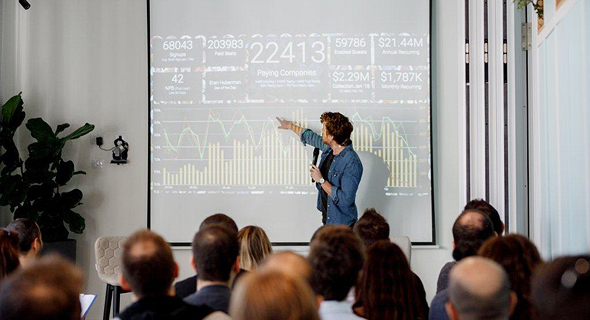Opinion
Metrics to Focus on During the Growth Stage of Your SaaS Journey: Part 2
While necessary to track progress, standard metrics like ARR, CAC, and ACV fall short of thoroughly analyzing your company’s growth trajectory
16:5017.07.18
As your software-as-a-service (SaaS) company grows, you may realize that standard metrics—like annual recurring revenue (ARR), customer acquisition cost (CAC), lifetime value (LTV), and annual contract value (ACV)—are insufficient to truly understand how to maximize your company’s growth trajectory.
 Eran Zinman lecturing. Photo: Monday.com
Eran Zinman lecturing. Photo: Monday.com
 Monday.com co-founders Roy Man and Eran Zinman. Photo: Monday.com
Monday.com co-founders Roy Man and Eran Zinman. Photo: Monday.com
For daily updates, subscribe to our newsletter by clicking here.
In part one of this article, I shared some of the challenges and additional metrics that we track at monday.com to help us scale effectively. We discussed intent and predictions, cash payback, cash cycle and sales net contribution.
Here, I will delve into three more super important metrics to focus on when you’re in the growth stage of building your startup: churn, growth speed, and team alignment.
 Eran Zinman lecturing. Photo: Monday.com
Eran Zinman lecturing. Photo: Monday.com
Churn
Let’s dig deep on churn. While it has a huge impact on your business, I am continuously surprised by what an imprecise metric it is. I remember a few years back when my co-founder Roy and I would share our churn rate with investors. The same exact figures would prompt some investors to give us a pat on the back and congratulate us while others looked deeply concerned and told us we needed to improve. Every SaaS company’s trajectory is different and measuring churn is super subjective.
Churn rates vary tremendously between software that target small and medium-sized businesses (SMBs), compared to software that target enterprise companies. SMBs tend to shut down their businesses more often and are more price sensitive. For example, an SMB is more likely to pause a subscription for two months to save money and then use it again, while an enterprise might save the hassle and bear the cost.
When you measure churn in order to present to potential investors, it is important to determine the best way to segment your customers. Here are a few tips on how to manipulate your churn rate in the most legitimate way:
1. Don’t count churn in the first 90 days. You can assume your users are still testing out the system.
2. Don’t count churn if the customer returns within the first 365 days.
3. Divide SMBs and enterprise accounts into different segments.
I like to think of “negative revenue churn” as the holy grail. You achieve negative revenue churn when expansion revenue from existing customers (any revenue generated on top of initial revenue earned) is higher than lost revenue from churning customers. If you have negative revenue churn on your cohorts—even if it is only -0.01%—that’s amazing. This is mainly because you don’t need to fear that the bucket is leaking, meaning all month-to-month revenue (MRR) you add will stay with you as you scale. You should strive for expansion revenue at every stage of your relationship with your users—throughout sales processes, during onboarding, and as they continue to use your product—because it’s a lot easier and less expensive to get more money from a happy existing customer than to get money from new customers.
Overall, I believe churn is one of the most important factors in scaling a company. Most companies can hit a wall when they reach $20- $30 million ARR if they have really high churn rates. Churn can eat away at your revenue and eventually suppress growth from new customers.
Growth speed
It’s important to remember that the journey of a SaaS entrepreneur is a long one. The best SaaS companies get to $100 million—and potentially to an IPO—within 7–10 years. We’re in it for the long haul! As management, you always need to be looking ahead at how to sustain your growth. You need to determine what your growth engines are and what you are going to build in order to accelerate revenue for next year. Ask yourself questions like are your marketing channels sustainable? Are they scalable? And so on.
Venture capitalists are most interested in startups with a relatively high growth rate and therefore, almost always value startups on a revenue multiple, assuming they have fast growth.
So what might your journey look like?
• Years 1–3: Focus on product-market fit. It doesn’t really matter how long it takes you to get initial traction (from $0 to $1 million ARR).
• After $1 million ARR: Growth rate becomes critical. Aim to go from $1.5 million to $10 million in five quarters or less.
• After $10 million ARR: Aim to grow at least 100% year over year. Meaning $10 million to $20 million, $20 million to $40 million, and $40 million to $80 million, and more.
Fast growth builds incredible momentum and it will affect everything in your company in a super exciting way. To achieve fast growth, this means 200% year over year at $1 million+ ARR, 100% year over year at $10 million+ ARR, or 50% year over year at $100 million+ ARR. It affects how everyone thinks and how fast you move. Ultimately, we are big believers in “land grabbing” and that the “winner takes it all”. Go for it!
 Monday.com co-founders Roy Man and Eran Zinman. Photo: Monday.com
Monday.com co-founders Roy Man and Eran Zinman. Photo: Monday.com
Team alingment
Once you have all your numbers and metrics, it’s super important to get your team aligned. We encourage every person in the company — numbers oriented or otherwise, including HR, customer success, marketing, account management, R&D, designers, content, and beyond —to understand and value our metrics.
To start, we are totally transparent. We project our shared goals on 71 screens around the office, in addition to displaying specific goals for individual teams. This is a way to align the entire team and empower people with information, but it is also a strategic business decision.
We believe in the people we hire and want to give them every opportunity to succeed and just run with it. When people come into the office in the morning, they are not aimlessly looking for direction. They arrive in-the-know, engaged, and empowered. We strongly believe in our entire team having every piece of information possible to better do their jobs. Together, we share the challenge of building the best possible platform and company we can.
Picking the right metrics to align your team around is super important. You have to choose well and be ready to pivot as things change. As an example, choosing revenue as your primary metric is problematic. When you direct your team to focus on revenue, they may focus only on how to extract the maximum amount of money from every customer, and not necessarily on increasing the overall value that a customer gains from your platform.
Instead, I encourage you to pick a metric that is related to the value your users are getting and is a sufficient proxy for revenue. At monday.com, we have aligned our team around a user engagement metric. On our platform, teams pay per the number of users in the account. Instead of focusing on revenue earned, we focus on how to maximize delivering more value and satisfaction to our users.
Related stories:
- Team Management Startup Monday.com Raises $50 Million
- Metrics to Focus on During the Growth Stage of your SaaS Journey
- Workplace Management Company SpaceIQ Raises $2.5 Million
We believe in aligning our team so deeply, that we do some pretty radical things to facilitate it. In addition to the 71 dashboards spread all around the office, we have weekly meetings with the entire company to review numbers from the previous week. We take the time to talk through what’s working, what’s not, and to collect ideas from everyone about what we can do to improve. When we opened our New York office earlier this year, bringing in dashboards to the new space was one of the first things we did.
Defining the right metrics is very empowering for any kind of team. It’s invaluable for a designer to understand how effectively her banner attracted new customers or for a content writer to be aware of which posts are high converting.
In this series, we covered just a few of the metrics that have helped us along the path of building monday.com. We have learned so much and continue to learn more each day. I hope you will find these useful and I encourage you to reach out with any questions.
Eran Zinman is the co-founder and CTO of Monday.com, a team management tool designed to be the first thing users check upon arriving in the office and the last before they leave.



